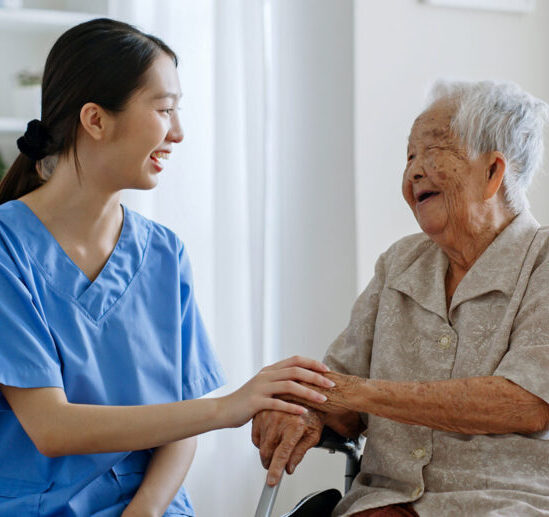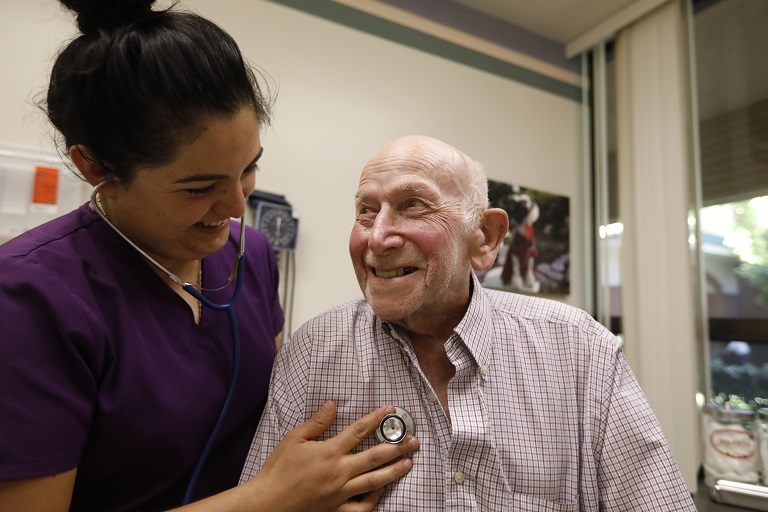CAST’s new video, called , follows 83-year-old Alma Jones on her journey from home to hospital, rehabilitation and back home. Over the next 12 months, CAST will be exploring the technologies that helped our fictitious video character live independently. In this first installment of our series on “Alma’s Technology,” CAST Executive Director Majd Alwan explores personal emergency responses systems.
“All this technology made the impossible possible. Now I’m not afraid to be alone. I’m not afraid at all.”
Those words come from Alma Jones, the central character in CAST new video, called High-Tech Aging: Improving Lives Today. The video follows 83-year-old Alma on her journey from home to hospital, rehabilitation and back home. That journey is assisted by a variety of technologies that help facilitate coordinated care and aging in place.
Over the next 12 months, CAST will be exploring in more depth the technologies that helped our fictitious video character live independently, receive better quality coordinated care and – most importantly – live without fear. In this first installment of our series on “Alma’s Technology,” I’d like to explore personal emergency responses systems or PERS.
Falls: A Major Public Health Problem
Personal emergency response systems enjoy the broadest adoption among LeadingAge members and are more likely than any other technology to be covered under Medicaid Waiver programs. Forty-eight states reimburse this type of technology nationwide. For more information, check your state’s information.
PERS systems help our members respond to a major public health problem, particularly among older adults. Approximately one-third of adults age 65 and older experience a fall each year. These falls can have a direct and lasting impact on older adults’ functioning and independence.
According to a recent Report to Congress on aging services technologies written by CAST and NORC, a research organization at the University of Chicago, falls can result in:
- Death and serious injury: Falls can cause hip fracture and traumatic brain injury, as well as less serious injuries like bruises and lacerations.
- Fear: Many older adults who experience a fall develop profound fears of a future fall. This can lead to reduced levels of physical activity.
- Health care spending: Falls are also the most common cause of emergency department visits and trauma-related hospital admissions among older adults. In 2000, fall-related costs totaled more than $19 billion, $179 million of which was due to fatal falls.
PERS: Bringing Help Fast after a Fall
Significantly, older adults who receive help within 1 hour of a fall are nearly 6 times more likely to survive than those who wait longer for aid, according to a 1996 study. This leads me to believe that technologies that detect falls early and send help fast can make the world of difference in reducing mortality and other consequences of falls. And that’s where PERS come in.
A PERS typically consists of 3 elements:
- A radio transmitter, usually embedded in a pendant that is worn around the neck.
- A console that receives the call for help and sends that call to an organization’s staff or an outside emergency response center.
- Staff or the emergency response center monitor calls and send help.
In a more traditional PERS system, the user must push a button on his or her pendant in order to send the help signal. The home base opens a 2-way communication that allows staff or the call center to communicate with the user to verify the need, and then send emergency responders. But over the past 30 years, the design of PERS systems has come a long way.
Today, we have more sophisticated systems that integrate sensors in the pendant/device. These sensors can detect falls automatically and send the help signal if a fall occurs, rather than waiting for the user to push the button.
Even newer PERS take advantage of cellular technology, allowing them to work outside the home, and GPS systems that help locate the user in case of an emergency. These systems help older adults remain active after they have recovered from an initial fall.
One of these third-generation systems will be released in March 2013. In the near future, sensor-laden wearable PERS systems will have the potential to monitor physical activity, walking characteristics, and/or balance to identify heightened fall risk of a user and to alert caregivers.
Tips for Using PERS Most Effectively
Aging services organizations seeking to purchase a new PERS system should keep several things in mind when making their selection:
- Who is going to respond to calls? You’ll have a choice to outsource the response responsibility to an outside call center that will handle calls for help, or to depend on your staff to be the first responders in an emergency.
- What will the system’s range be? Will the PERS work only in a resident’s apartment? Throughout your campus? In the community?
- Will the user need to push a button to get help? Auto-detection features can add slightly to the cost of your PERS, but it may be worth the expense to overcome non-compliance. That non-compliance might be unintentional if a resident loses consciousness and cannot push the pendant’s button after a fall. But it also could be intentional, if a resident falls in the middle of the night but refrains from pushing the button so as not to “bother” anyone.
PERS as Part of an Overall Falls Prevention Strategy
PERS should be considered as a safety net, and must be incorporated with programs to prevent falls and ensure the safety of residents and clients.
The key to such programs is identifying residents and clients who have a tendency to fall and then finding the root cause of falls through a full risk assessment. Some important steps include:
- Reviewing the individual’s medical record to determine if medical conditions and medications are causing dizziness or other symptoms that could lead to falls. Electronic Health Records (EHR) facilitate such record reviews, and EHR vendors are starting to implement clinical decision support systems that flag individuals at high-risk of falling, and provide suggested strategies to reduce those risks.
- Assessing the living environment and taking steps to remove throw rugs, enhance lighting and smooth out thresholds.
- Encouraging residents to participate in physical therapy, tai chi and other exercise programs that can strengthen muscles in the lower extremities and improve balance.
- Providing assistive devices that could help prevent falls.
Finally, it’s important to recognize that PERS are not fool proof. You may want to consider deploying a passive monitoring system as a backup to your PERS system. For example, motion sensors can detect a possible fall in cases where the resident is not wearing the PERS pendant. Sensors in the floor can also be used to detect the impact of a fall and call for help. This is especially important for users who have a PERS but forget to wear it.
I recommend watching the full-version of the Alma video, and I would encourage you to check the safety technologies section of CAST’s report on the State of Technology in Aging Services to find out relevant information and technologies.

 Shutdown Week Three: Impact of Ongoing Closure on Affordable Housing
Shutdown Week Three: Impact of Ongoing Closure on Affordable Housing


